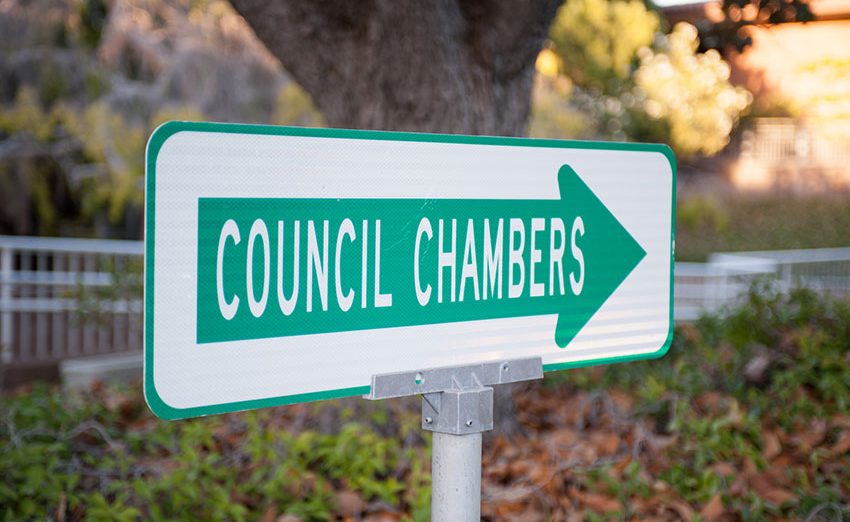Attempts to relocate the courthouse to make way to revitalize Santa Clara’s downtown have fallen flat.
In a report during a special meeting Wednesday night, City Manager Deanna Santana informed the Council that the judicial council has “no interest” in relocating the courthouse. The Council drafted a letter back in September requesting consideration to relocate the courthouse to make room to redevelop the City’s downtown.
Bringing the downtown back to prominence has been a focus of the civic group Reclaiming Our Downtown, but without the go-ahead from the judicial council, the effort has stalled.
While things look bleak for the prospect of the effort, Manuel Pineda, Assistant City Manager, said the parcel will continue to be part of the Downtown Task Force’s discussions on land-use. Santana assured the Council that City employees will “continue to check in” on the judicial council’s view on relocating the courthouse.
“You can always keep asking, and they can always say ‘no,’” she said.
Council Member Kevin Park said the Council needs to “look beyond the request” to find a way to give residents what they really want — a downtown. That doesn’t necessarily have to involve moving the courthouse, he said.
Dan Ondrasek, co-chair Reclaiming Our Downtown, said the news displeased his group.
“When the idea of a letter was suggested, we knew that this would be the outcome,” he wrote in an e-comment. “It is unfortunate with both the resources of both city staff and city management. We were hoping the city would come forward with solutions surrounding this issue and not a letter.”
Ondrasek wrote that his group is working on other solutions, saying it will need the support of the Council to accomplish its goal. He told the Council to “standby” for further details.
Council Member Anthony Becker said “the door is not closed.”
Council Gives Thumbs Up To HUD Plan
The Council also approved the housing department’s plan for U.S. Department Housing and Urban Development (HUD) money.
Jonathan Veach, Housing Division Manager, presented to the Council how his department has been spending federal dollars and how it plans to continue to spend that money. The lion’s share of HUD money is used for housing assistance and the Neighborhood Improvement Conservation Program (NCIP).
The former helps those on the edge of homelessness stay afloat by allowing them to pay 30 percent of their income to rent homes they would otherwise be unable to afford. The latter provides low-interest loans with deferred payments to improve old homes.
The remainder of the programs provide public services such as assistance for seniors and victims of domestic violence.
Of the $1.6 million the City received as part of COVID-19 aid, the HUD programs received an additional $137,384, which, upon Veach’s recommendation, the Council allocated to the rental assistance program.
This year, the program subsidized rent for 46 households, funded 21 NCIP projects and provided more than 5,000 public services.
As a renter, Becker said the programs “hit home.” The Council approved the plan and related budget amendment unanimously.
Concrete Wall Proves Contentious
The Council also referred a request from a local man to halt the building of a 10-foot tall concrete wall to City employees.
Sam Liu, the petitioner, claims construction of a concrete wall as part of a development project at 3200 Scott Blvd. would pose a hazard. An earthquake or other such disaster could cause the wall to collapse, Liu said. Getting clearance from the proposed wall — based on Occupational Safety and Health Administration guidelines — would require vacating 29 of 66 parking spaces.
The Council unanimously approved City employees looking into the details and reporting back to them at its Jan. 26, 2021 meeting.
Bad Blood Among the Council Continues
Squabbling among Council Members continued from last week’s meeting. During the public comments section, former Council Member Teresa O’Neill called in to question the transparency of the new Council Members asking them pointedly to disclose any dealing they had with the plaintiffs or lawyer involved in the California Voting Rights Act lawsuit.
After each Council Member in turn disclosed any such dealings, Kathy Watanabe continued the purity test by questioning whether Council Members spoke to anyone associated with the 49ers about the case, which the Council Member also then divulged.
Consent Calendar Spending
The Council approved the following spending via the consent calendar:
- An amendment to a contract for “professional services” with Aspen Environmental Group, Inc. increasing the contract by $395,933, for a total not-to-exceed value of $825,861
- An amendment to a contract for “professional services” with Electrical Consultants, Inc. increasing the contract by $1,540,551, for a total not-to-exceed value of $3.9 million
- A contract extension with Moore Iacofano Goltsman, Inc., for preparation of the Patrick Henry Drive Specific Plan to expand the scope of services and increase the total not to exceed amount to $1.01 million
- An amendment to a contract with Metropolitan Planning Group for “dedicated planning services” for Tasman East development projects and increase the total not to exceed amount to $147,000
- $1 million to “various vendors” as required to complete all repairs at the Gianera Generating Station
The Council meets again Tuesday, Jan. 12, 2021 in the Council Chambers at City Hall, 1500 Warburton Ave. in Santa Clara.
Members of the public can participate in the City Council meetings on Zoom at https://santaclaraca.zoom.us/j/99706759306; Meeting ID: 997-0675-9306 or call 1(669) 900-6833, via the City’s eComment (available during the meeting) or by email to PublicComment@santaclaraca.gov.








Squabbling? Purity test? Asking for transparency is not a bad thing. These new councilmembers ran on a platform of transparency. If they had direct contact with the plaintiffs or attorney in the CVRA case, they should have initiated disclosure of the contact. The fact that it did not come out until they were questioned directly makes one wonder about their “transparency.”